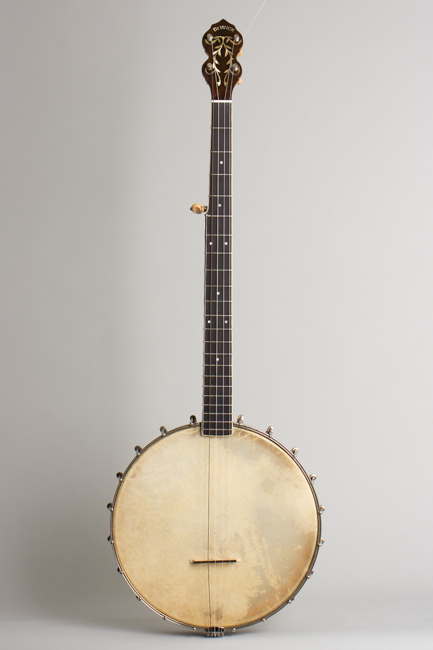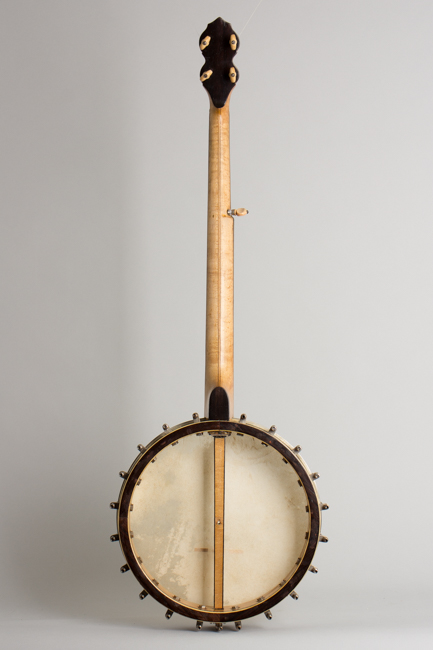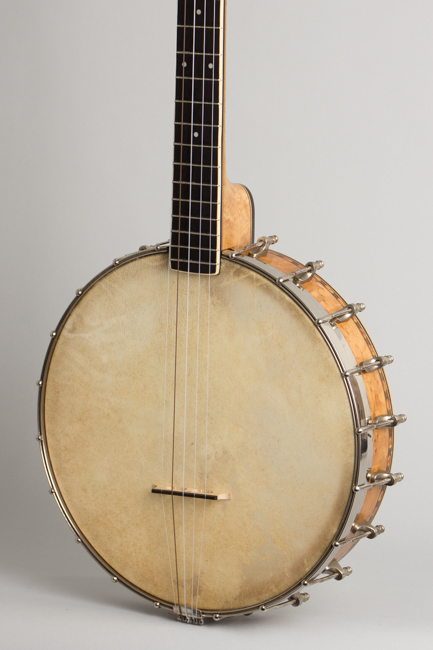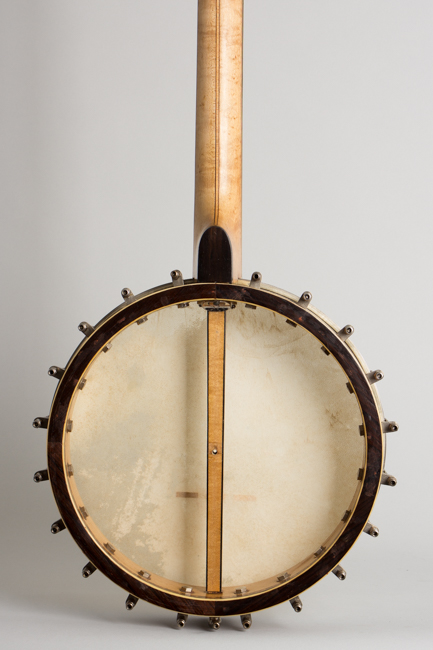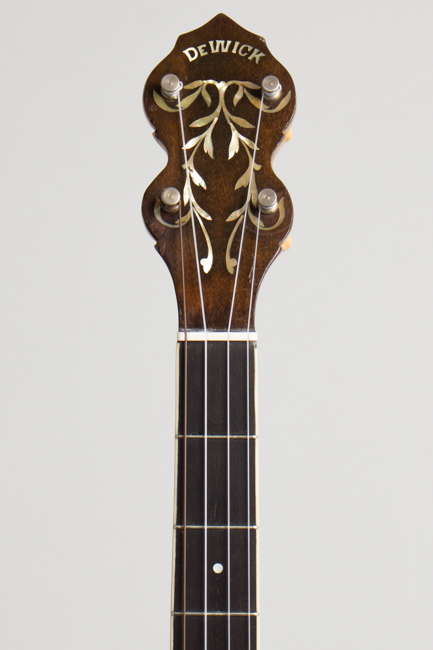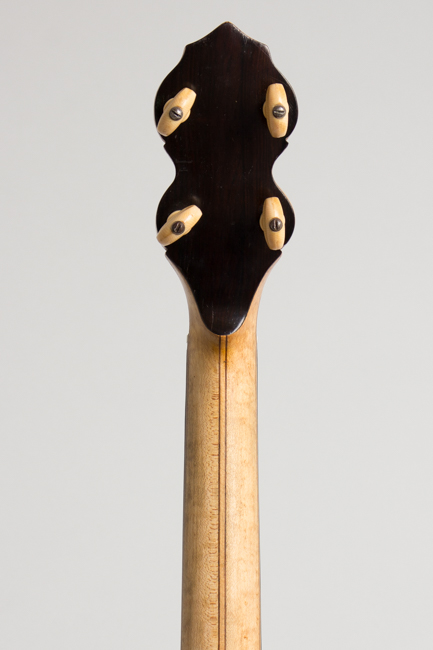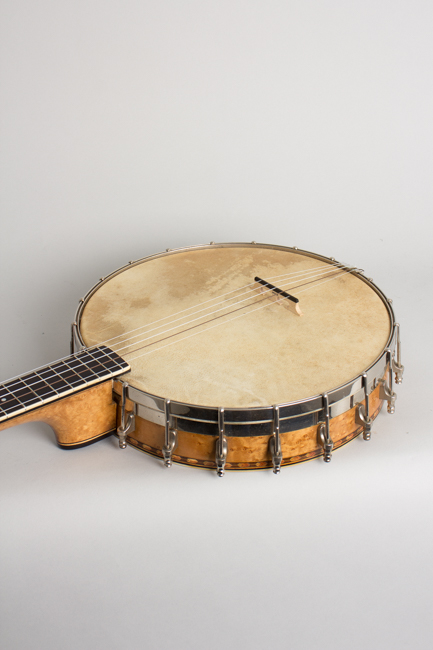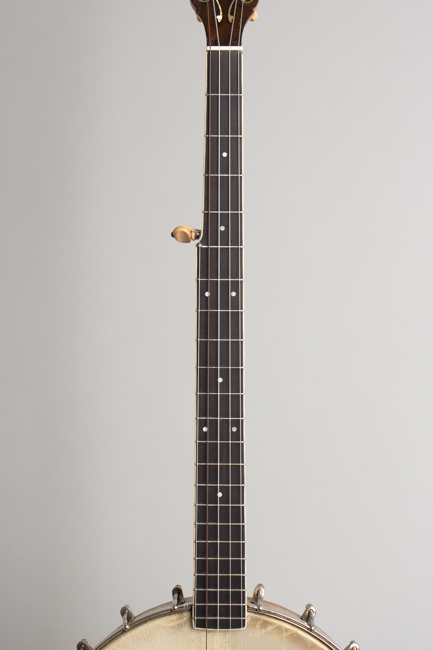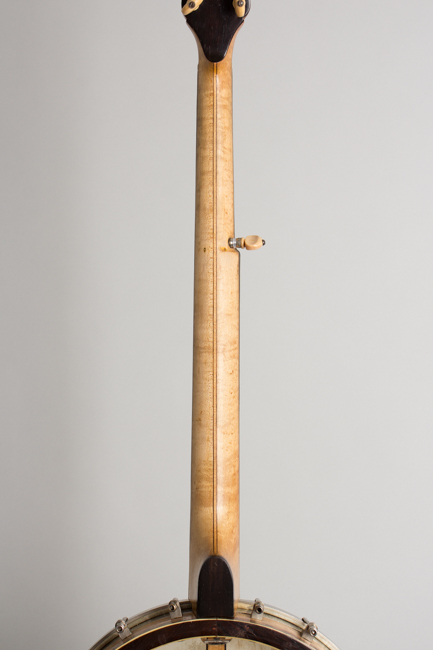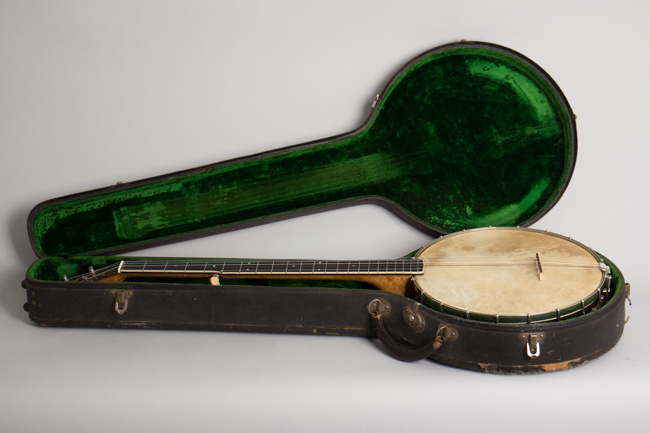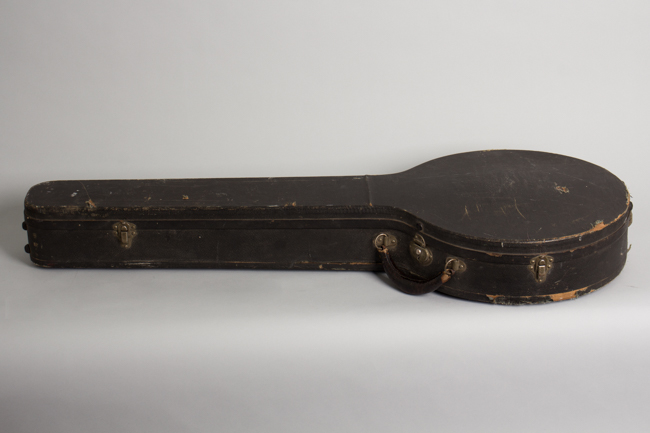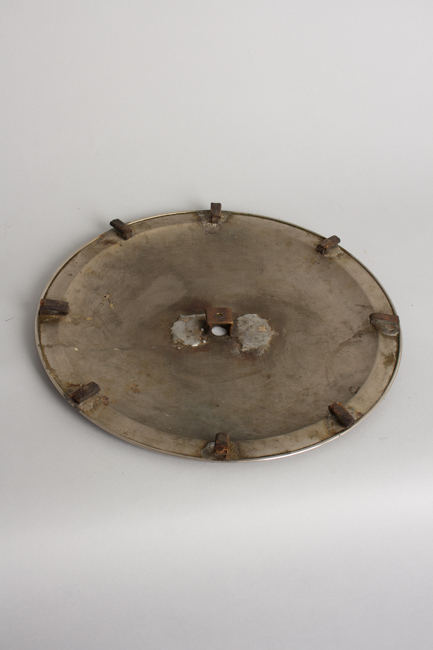DeWick 5 String Banjo , c. 1915
This item has been sold.
Item # 11497
Prices subject to change without notice.
DeWick 5 String Banjo, c. 1915, made in Brooklyn, NY, natural varnish finish, laminated maple neck and rim, ebonized fingerboard, original black hard shell case.
This is an interesting 100+ year old 5-string banjo made right here in Brooklyn, NY carrying the name of one of the borough's lost instrument pioneers, William H. DeWick. DeWick was a banjo performer, teacher, inventor and general banjoistic dabbler with a career spanning the 1890s classic era 5-string right through to the jazzy '20s. By 1892 his teaching studio was at 591 Fulton Street, he later partnered in that business with Charles E. Dobson of the banjo-centric Dobson family.
At the same time He actively performed with banjo, mandolin and guitar as The DeWick Trio, apparently employing his wife and daughter. This "refined musical act" was a presence on the vaudeville circuit through at least 1910. Turning to invention, he authored two mandolin patents in 1911 and 1912, followed by two banjo patents in the mid 1920s. These covered his De Wick "Ideal" Banjo patented neck adjuster, built-in resonator and brackets integrated into the rim. DeWick claimed to be the maker of these but like many period teacher/player/inventors almost certainly sourced his banjos from other factories, or at least the parts prior to assembly.
This particular 5-string banjo predates DeWick's patented neck adjustment and resonator concepts, filed in 1922. It is a large rim, medium-fancy if fairly conventional instrument of its time. The 27" scale neck is made of laminated maple with multiple wood underlays and an extended bound ebony fingerboard. The headstock is veneered with a "DeWick" logo and leaf motif in pearl. The rim is laminated maple as well, bound and capped with a marquetry strip around the base inside and out. This is surmounted by a sheathed tone ring and fitted with typical better grade period hardware. The finish overall is a very thin clear varnish.
As to who actually made the instrument for DeWick, Slingerland in Chicago is the usual suspect but this one almost certainly predates that company's banjo efforts. Rettberg & Lange in Manhattan are a possibility, but Gretsch (also in Brooklyn) is the most likely suspect based on the construction and especially the shape of the headstock volute. Whoever built it this is a very good quality instrument, well made, sturdy and a very nice player with the warmer sonic character of a long scale and large rim. This survives as a testament to the redoubtable Mr. DeWick's long lost Brooklyn banjo empire.
Overall length is 37 in. (94 cm.), 12 1/8 in. (30.8 cm.) diameter head, and 2 13/16 in. (7.1 cm.) in depth, measured at side of rim. Scale length is 27 in. (686 mm.). Width of nut is 1 1/4 in. (32 mm.).
For being at least 100 years old this banjo is in very nice condition, fully playable and largely unaltered. The original finish is very thin; it is worn through in spots with small dings and dents on the neck and rim but nothing overly conspicuous. There is some scraping and scuffing on the bottom of the rim.
The hardware is all original including a matched set of hooks and nuts, correct period friction tuners and a genuine No-Knot tailpiece. The plating shows some wear but nothing too serious. The fingerboard has been refretted with slightly larger wire than original, a good job but the binding was cut through as part of the process. At some point someone did the old trick of re-drilling the neck and dowel attachment to a different orientation, but that has been corrected and the banjo is now solidly and correctly set up. This has left an extra endpin screw hole in the back of the rim and some small screw marks around an enlarged dowel hole, visible but not an ongoing issue.
The banjo has an added period metal plate resonator included, not currently mounted (most players today prefer an openback configuration) but useable if desired. This attachment left a hole and some scarring on the dowel stick and caused most of the scraping on the rim capping. The instrument is set up with an old calfskin head, modern Grover bridge and NylGut strings for an authentic period sound; it is stoutly built enough to hold steel strings if desired. It is a very good player with a nicely authentic deeper sound, complete in the original green-lined HSC. Overall Excellent - Condition.
This is an interesting 100+ year old 5-string banjo made right here in Brooklyn, NY carrying the name of one of the borough's lost instrument pioneers, William H. DeWick. DeWick was a banjo performer, teacher, inventor and general banjoistic dabbler with a career spanning the 1890s classic era 5-string right through to the jazzy '20s. By 1892 his teaching studio was at 591 Fulton Street, he later partnered in that business with Charles E. Dobson of the banjo-centric Dobson family.
At the same time He actively performed with banjo, mandolin and guitar as The DeWick Trio, apparently employing his wife and daughter. This "refined musical act" was a presence on the vaudeville circuit through at least 1910. Turning to invention, he authored two mandolin patents in 1911 and 1912, followed by two banjo patents in the mid 1920s. These covered his De Wick "Ideal" Banjo patented neck adjuster, built-in resonator and brackets integrated into the rim. DeWick claimed to be the maker of these but like many period teacher/player/inventors almost certainly sourced his banjos from other factories, or at least the parts prior to assembly.
This particular 5-string banjo predates DeWick's patented neck adjustment and resonator concepts, filed in 1922. It is a large rim, medium-fancy if fairly conventional instrument of its time. The 27" scale neck is made of laminated maple with multiple wood underlays and an extended bound ebony fingerboard. The headstock is veneered with a "DeWick" logo and leaf motif in pearl. The rim is laminated maple as well, bound and capped with a marquetry strip around the base inside and out. This is surmounted by a sheathed tone ring and fitted with typical better grade period hardware. The finish overall is a very thin clear varnish.
As to who actually made the instrument for DeWick, Slingerland in Chicago is the usual suspect but this one almost certainly predates that company's banjo efforts. Rettberg & Lange in Manhattan are a possibility, but Gretsch (also in Brooklyn) is the most likely suspect based on the construction and especially the shape of the headstock volute. Whoever built it this is a very good quality instrument, well made, sturdy and a very nice player with the warmer sonic character of a long scale and large rim. This survives as a testament to the redoubtable Mr. DeWick's long lost Brooklyn banjo empire.
Overall length is 37 in. (94 cm.), 12 1/8 in. (30.8 cm.) diameter head, and 2 13/16 in. (7.1 cm.) in depth, measured at side of rim. Scale length is 27 in. (686 mm.). Width of nut is 1 1/4 in. (32 mm.).
For being at least 100 years old this banjo is in very nice condition, fully playable and largely unaltered. The original finish is very thin; it is worn through in spots with small dings and dents on the neck and rim but nothing overly conspicuous. There is some scraping and scuffing on the bottom of the rim.
The hardware is all original including a matched set of hooks and nuts, correct period friction tuners and a genuine No-Knot tailpiece. The plating shows some wear but nothing too serious. The fingerboard has been refretted with slightly larger wire than original, a good job but the binding was cut through as part of the process. At some point someone did the old trick of re-drilling the neck and dowel attachment to a different orientation, but that has been corrected and the banjo is now solidly and correctly set up. This has left an extra endpin screw hole in the back of the rim and some small screw marks around an enlarged dowel hole, visible but not an ongoing issue.
The banjo has an added period metal plate resonator included, not currently mounted (most players today prefer an openback configuration) but useable if desired. This attachment left a hole and some scarring on the dowel stick and caused most of the scraping on the rim capping. The instrument is set up with an old calfskin head, modern Grover bridge and NylGut strings for an authentic period sound; it is stoutly built enough to hold steel strings if desired. It is a very good player with a nicely authentic deeper sound, complete in the original green-lined HSC. Overall Excellent - Condition.
